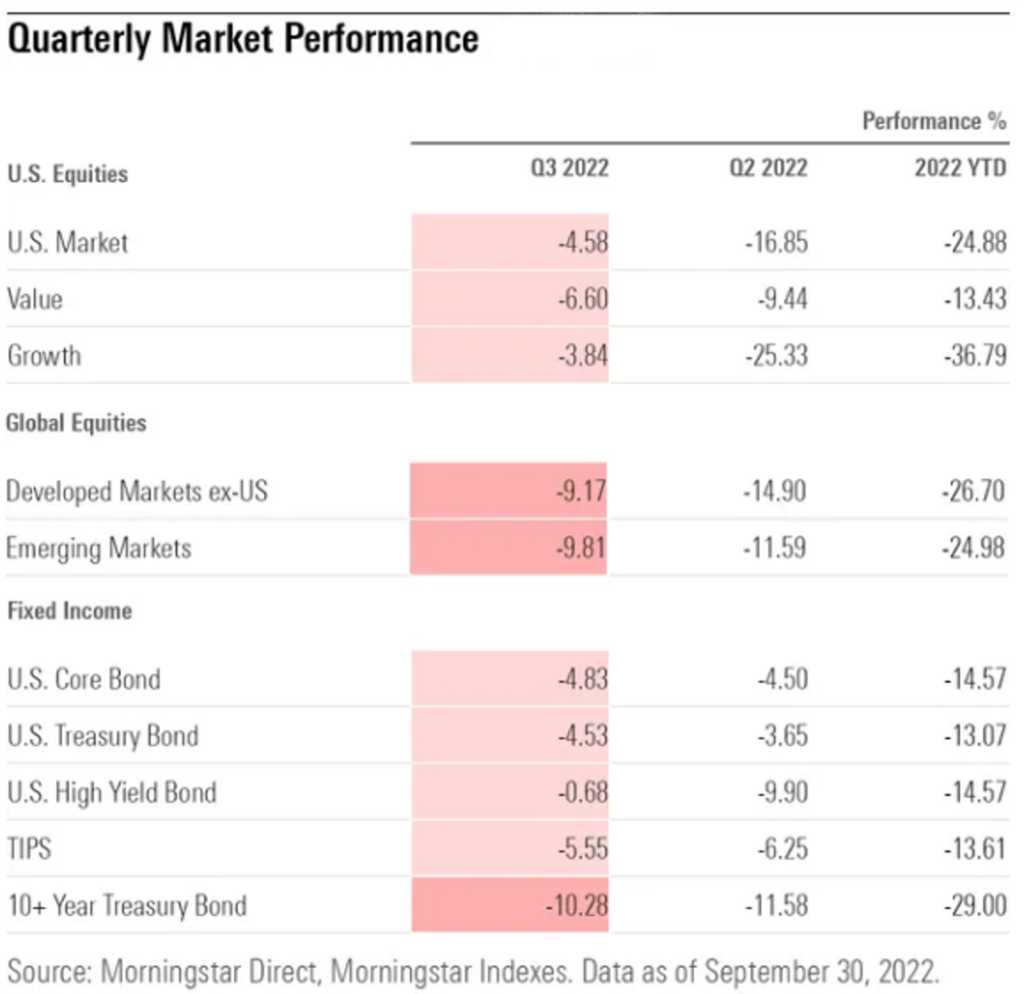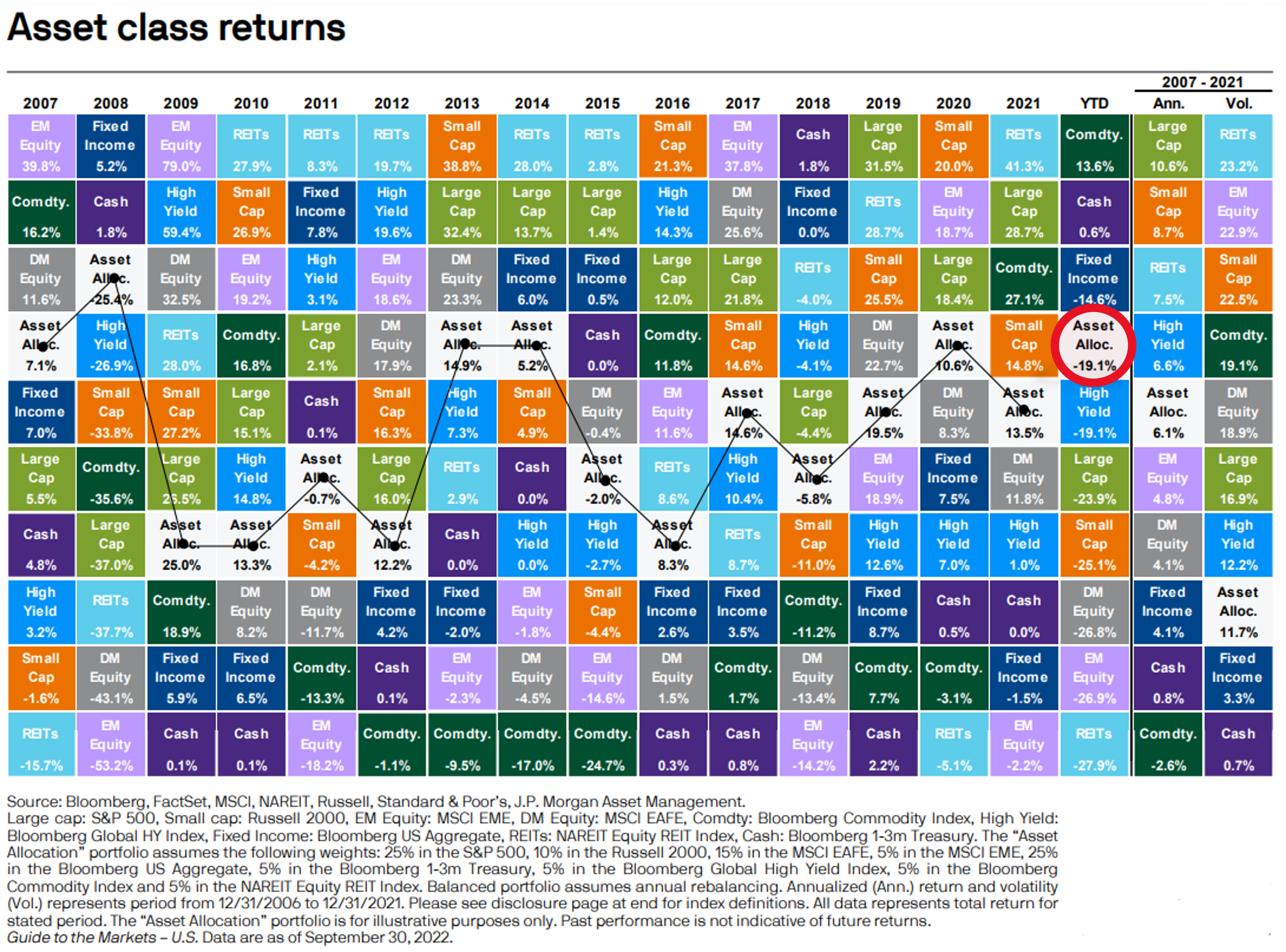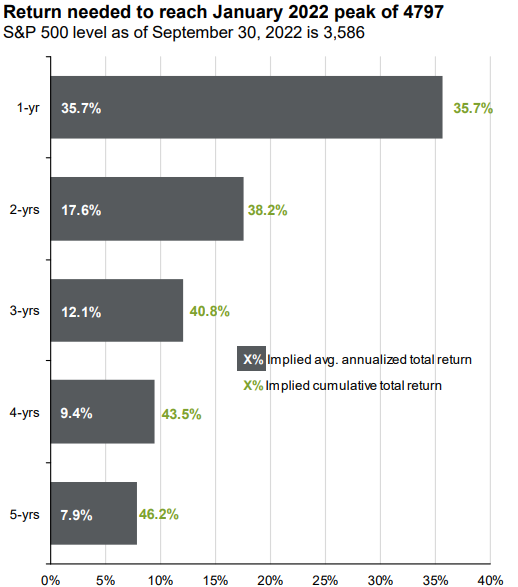While we’re not certain when the market will change course, this bear market, like all prior bear markets, will eventually end. Until then, a diversified portfolio is still a solid strategy for navigating the current turbulent market.
In the third quarter, we experienced volatile financial markets and further year-to-date declines. The key causes for these troubling results continue to be abnormally high inflation leading to aggressive interest rate hikes by the U.S. Federal Reserve and global central banks. This, combined with lingering effects from the pandemic and Russia’s war in Ukraine, are increasing the odds of a global recession.
While equity markets did see a significant relief rally in July and August, the S&P 500 closed September 30 at a new low for the year, down 24%. Bonds also saw negative returns this quarter and, in some cases, are down more than conservative parts of the equity market. Below is a summary of asset class performance YTD:

Why Stay with a Diversified Portfolio?
Substantial losses across almost all asset classes have many questioning if diversification still “works” when it comes to investing. The short answer is, yes.
The below chart of Asset Class Returns shows the fourth best performer this year is a diversified portfolio. The diversified portfolio, titled Asset Alloc. in the white box, is approximately 60% stocks and 40% bonds. This portfolio is down -19.1%, which is a “better” result than the remaining six asset classes. Only two asset classes have produced positive returns thus far in 2022, Commodities and Cash. Commodities have returned 13.6% and cash has returned 0.6% year to date. All other traditional asset classes are down well over 10%, including bonds. See below:

Experiencing a -19.1% return in a diversified portfolio certainly does not feel like something is “working”. The only time this portfolio showed worse results above was in 2008, during the Great Financial Crisis.
However, when compared to a non-diversified portfolio of Large Cap stocks down -23.9% or Real Estate down -27.9%, a diversified portfolio is providing a better return; just not the result most have grown accustomed to receiving in recent years. The three-years prior (2019-2021) were strong results for the Asset Allocation portfolio, up 19.6%, 10.6% and 13.5% respectively. On average, the return for this diversified 60/40 portfolio has been a positive 6.1% annually between 2007-2021 even when accounting for multiple years with negative returns. And, while having a concentrated portfolio of Commodities and Cash would have worked great this year, the above chart shows that longer term results would have investors questioning that approach.
Looking Forward
The bond portion of diversified portfolios has not provided the expected protection from losses in 2022 due to the speed and size of interest rate hikes. Bonds have also paid little interest for much of the past decade.
Today fixed income assets are providing 3-4% yields that can be collected in shorter term, safer investments. We can also invest in longer maturity bonds at these rates. The benefit is that the fixed income portion of portfolios going forward can provide lower risk returns today and potentially provide downside protection longer term, once inflation moderates.
It’s unknown when equity markets will change course and begin providing returns long term investors have come to expect. Often the change in direction happens while bad economic news continues to worsen. This bear market will eventually end like all prior bear markets, so what are some reasonable expectations looking forward? The below chart shows what equity market returns would be if we returned to market highs of January 2022 over various time frames:

Above, we see the most conservative recovery scenario of five years would equate to a 7.9% average annual equity return. If combined with a 3.5% fixed income return in a 60/40 portfolio, returns would outpace current longer term inflation expectations and provide some real asset growth.
Staying with the Plan
While anything can happen over the next five years in both equity and fixed income markets, history has shown that bear markets do eventually end, and patient investors have been rewarded. During volatile markets, diversification does work. In fact, bear markets often provide opportunities to optimistic investors. While we watch and wait for better investment opportunities, diversified portfolios consisting of more conservative value-oriented equities, shorter duration bonds and commodities has been helpful in limiting losses.
Checking in periodically with your Planner is helpful in staying with the plan to double check that you are still on track with your financial goals and to potentially find opportunities when looking forward.
































0 Comments